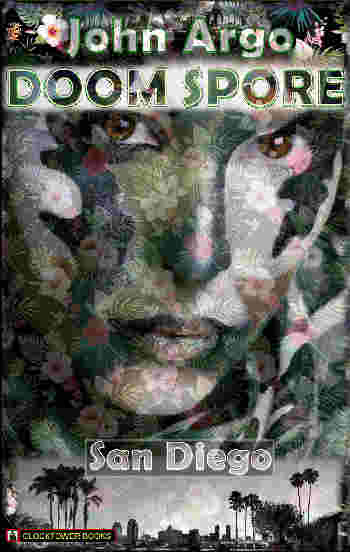10.
 Neither James Robertson, 50, nor his father James, 80, smiled much on this trip. Etta Robertson, the elder James' wife and the younger James' beloved mother, had recently died after a long illness. Etta's cancer had left a pile of debts, and her two surviving men were doing what they must to at least save the house in Point Loma. The father had retired from the FBI toward the turn of the century, and had spent some more years in Civil Service. The younger man was balding and heavy, with thin frizzy white hair around a sun-burned, salmon-colored pate. The father was lean, with folded-putty skin that suggested he didn't go outdoors much anymore. His teeth were large and yellow, what he had left of them. He had wisps of thin white hair. Both men dressed alike: business shirt open at the neck; no tie or jacket; good suit pants; comfortable loafers that looked scuffed and about two years past their usable prime. Neither James Robertson, 50, nor his father James, 80, smiled much on this trip. Etta Robertson, the elder James' wife and the younger James' beloved mother, had recently died after a long illness. Etta's cancer had left a pile of debts, and her two surviving men were doing what they must to at least save the house in Point Loma. The father had retired from the FBI toward the turn of the century, and had spent some more years in Civil Service. The younger man was balding and heavy, with thin frizzy white hair around a sun-burned, salmon-colored pate. The father was lean, with folded-putty skin that suggested he didn't go outdoors much anymore. His teeth were large and yellow, what he had left of them. He had wisps of thin white hair. Both men dressed alike: business shirt open at the neck; no tie or jacket; good suit pants; comfortable loafers that looked scuffed and about two years past their usable prime.
The younger man had a degree in Liberal Arts, and did peripheral engineering work—technical writing, web design—when he could find a temporary gig at one of San Diego's midsize firms. James Jr. drove, while James Sr. fussed with a map that kept fluttering in the hot wind entering the car. The air conditioning didn't work too well, and there hadn't been time or money to get it repaired—a fact the two regretted now as they crossed the desert. The old man, who was now also dying of cancer, and wanted to leave something to his son, got a distant look in his eyes and reminisced about his days in China and Burma, where his had been one of the O.S.S. units cleaning up after the Japanese withdrawal.
James Jr. was a quiet man, and he listened patiently. It was the Japanese documents that Collwood wanted so badly, and was willing to pay good money for.
"There she be," James Sr. said, waving a bony hand at the distant, bluish shadows of Anaconda Chemical buildings on the horizon. "Almost there now. Wonder how much he'll offer."
"Depends on how excited he gets about what you have."
"You know," James Sr. said, making a strained face with haunted eyes, "I've been losing sleep over doing this. You know what's in those papers, and I can promise you whatever this man wants them for so badly, he is up to no good."
The plant and offices of Anaconda Chemicals sprawl across the Southern California desert between Brawley and the Salton Sea. This is a region known as the Imperial Valley, which borders on Mexico to the south, San Diego County to the west, and Arizona to the east. The region contains some of the hottest, most arid terrain on earth.
North lies the Salton Sea, former salt flat into which Colorado River water accidentally flowed in 1905 to create a lake that has been choking on salt and chemicals ever since—despite its better years as a fishing spot and tourist attraction. Its fathoms are said to contain more than one bomber or fighter plane from nearby military installations over the generations.
A few dozen miles east, in San Diego County, lies the Anza-Borrego Desert, another place where you can fry an egg on the sidewalks of Borrego Springs at five o'clock on a July afternoon. You could probably bake a loaf of bread in your car trunk, though nobody is known to have tried it. And the desert is littered with the bleached bones of men and animals.
In this atmosphere, the patriarch of the Collwoods and founder of Anaconda, Lee Collwood, thought it would be good to join or sunder massive amounts of earthly chemicals for great profit, in privacy far from civilization. It wasn't until the later 20th Century that Uncle Sam actually built any major freeways in Anaconda's neighborhood.
The plant is of World War II vintage, with a sawtooth roof of many symmetrically angled skylights. Because of the various products made here, some of them used in war, the plant has always had a top U.S. Government security rating. It is surrounded by high, electric fencing. Its perimeter is patrolled by armed guards with dogs, riding air conditioned Hummvees. The plant has dozens of buildings large and small, spread over hundreds of acres of varied terrain, so that horseback and aircraft patrols are also necessary. The buildings are of a consistently mayonnaise yellow painted over stucco or wood, as distinct from the sandy, gravelly terrain with its mix of vegetation.
It is the kind of landscape in which tumbleweed rolls over wind-carved dunes, and the air has a kind of tense, overheated hum that overlays a graveyard silence. In spots where there is water close to the surface, perhaps in a dip, some stunted Manzanita oak might ply its twisting branches and sparse leaves, enough to offer cover to small birds warbling with joy. This is a place where you might see a sidewinder cruise by at high speed, sampling the air with its forked tongue while its body undulates like a coil in perpetual motion. You might see a roadrunner or a fox or even a Mexican wolf. You might see the U.S. Border Patrol (La Migra) drive by in their cream color and green SUVs with thick-knuckled thread tires, and moments later see a group of illegals (men, women, children) breaking for cover to cross a road and disappear among the sage and cactus, perhaps never to be seen again until their decaying remains are found a year or a century later. Except for the whine of La Migra vehicle's transmission, or the distant hum of a spotter plane, or the warbling of that bird, or the caw of a larger bird of prey or a flock of vultures, it all happens under a blanket of silence. This is where the Collwoods have cooked up their business schemes the way the chemists in their laboratories try new assays in boundlessly many combinations.



|
  Thank you for reading. If you love it, tell your friends. Please post a favorable review at Amazon, Good Reads, and other online resources. If you want to thank the author, you may also buy a copy for the low price of a cup of coffee. It's called Read-a-Latte: similar (or lower) price as a latte at your favorite coffeeshop, but the book lasts forever while the beverage is quickly gone. Thank you (JTC). Thank you for reading. If you love it, tell your friends. Please post a favorable review at Amazon, Good Reads, and other online resources. If you want to thank the author, you may also buy a copy for the low price of a cup of coffee. It's called Read-a-Latte: similar (or lower) price as a latte at your favorite coffeeshop, but the book lasts forever while the beverage is quickly gone. Thank you (JTC).
|
TOP
|
MAIN
Copyright © 2014 by Jean-Thomas Cullen, Clocktower Books. All Rights Reserved.
|